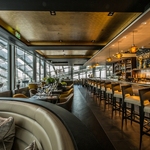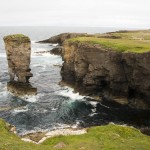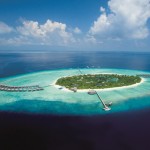Clare Jenkins slows down and heads up to ‘The Magnetic North’ for her Insider Guide to Orkney.
On a previous trip to Orkney, I got talking to a couple of young men from Shetland, who’d never been on a train or anywhere further south than Aberdeen. “Aberdeen was so busy,” said one, “and there was so much traffic.”
“And the way everyone was walking there,” his friend added, “if you walked that fast back home, people would want to know what you were running away from.”
It’s pretty much the same in Orkney, the group of 70 islands (only 20 inhabited) lying off the north of Scotland. Admittedly, at certain times of day (when the ferry’s in) there’s a fair bit of traffic on the main road between the port of Stromness and the capital, Kirkwall. But on other parts of Mainland (as the main island is confusingly called), you can drive for miles without passing more than a dozen cars. There are no dual carriageways, no traffic lights (apart from at roadworks), few zebra crossings, even fewer roundabouts.
As for Kirkwall airport: two runways, around eight flights a day, most carrying no more than 72 passengers. But that’s like Heathrow compared to the airport at North Ronaldsay.
North Ronaldsay – Orkney at its most extreme
When my husband Steve and I first visited Orkney’s most northerly island on a day trip 20 years ago, the eight-seater plane landed in the field that doubled as the airstrip. Cows ‘in silken coats’, as Orcadian poet George Mackay Brown described them, looked curiously up at us as we disembarked. After a few hours walking round the island (three miles long, one mile wide, a population then of 80), we arrived back at the ‘airport’ to catch the return flight.
“It’s not coming,” said the man in charge. “Fog.” And he started walking to his car.
“But what are we supposed to do now?” we asked. “Where can we stay?”
“Try the Bird Observatory,” he said, and drove off.


The Bird Observatory turned up trumps. Not just a bed for the night, but also a hot meal, convivial company (lots of young volunteer birders), and the right saline solution for my contact lenses (Kevin Woodbridge, the Viking-bearded founder of the Bird Obs was also the island doctor).
Things have changed a bit – not a lot – since then. There’s now a proper runway, for instance, complete with waiting hut. The rare breed of sheep still patrol the shoreline, but as born-and-bred islanders have died or moved away, the population has declined to nearer 50. And nowadays, most of them are ‘ferryloupers’ (incomers) in search of The Good Life. “It’s the light, the open spaces, the wildlife – and the peace,” as one explained.
It’s also the chance to see the Northern Lights. North Ronaldsay has Dark Sky status, making it a must-visit for astronomers. It is, after all, closer to Oslo than to London – and lies further north than Norway’s southern tip. Like the rest of Orkney, it feels very much part of The Magnetic North, more Scandinavian than British, what with its low-lying land, huge skies, wide horizons and vast expanses of water.
Orkney’s Viking past
Up to the 15th Century, Orkney belonged to Norway, only becoming part of the Scottish kingdom when given as dowry when Queen Margaret married James III. There’s still a Norwegian Consulate in Kirkwall, together with a thriving Orkney-Norway Friendship Association. And The Orcadian newspaper’s births, marriages and deaths columns are peppered with names like Thorfinn, Hakon, Solveig, Olaf…

The Viking influence is still felt elsewhere around the islands. The Neolithic burial mound of Maeshowe, for instance, was broken into by 12th Century Vikings, who left graffiti about who was sleeping with Ingeborg “the most beautiful of women”. Less lewd runes are to be found at the mysterious standing stones of the Ring of Brodgar – a World Heritage Site and favourite midsummer spot for pagans and newly-weds. You can even do a degree in Viking Studies at Kirkwall’s Institute for Northern Studies.
Then there’s the magnificent, rose-coloured St Magnus Cathedral, built by the Norse Earl Rognvald over 1,000 years ago in honour of his murdered uncle, Earl Magnus. Relics of both men are interred in large sandstone pillars here.
Orkney and war
The islands’ wartime heritage, meanwhile, is reflected in the gun emplacements dotted around the shores, along with the rusting remains of sunken boats. At Marwick Head – a fine place to watch seabirds, including guillemots, razorbills and puffins – there’s a memorial wall to the 737 men (including Lord Kitchener) who died near here in 1916 when the HMS Hampshire sank after striking a German mine.
Twenty miles south, in Scapa Flow’s natural harbour, the German Fleet was scuttled by its own sailors in 1919. Twenty years later, a German U-Boat penetrated the flow’s defences and torpedoed the battleship HMS Royal Oak, resulting in the loss of over 800 lives. A book of remembrance to the dead is always open in the cathedral.

Four barriers were subsequently built in the water to protect the Royal Navy’s main base at Scapa Flow. These concrete-block Churchill Barriers, 80 years old this year and linking five of the smaller islands, were built with the help of Italian prisoners-of-war, some of whom went on to create the ornate Italian Chapel – another tourist draw – out of two Nissen huts.
Stromness
Orkney’s wartime experiences are explored in the reassuringly traditional Stromness Museum, alongside its history of exploration. The Hudson Bay Company used to shelter here, draw water from the well, and take young men away to sea.
Among the islands’ most feted adventurers was Dr John Rae, Victorian explorer of northern Canada and the Northwest Passage and discoverer of the fate of the doomed Franklin expedition. The museum displays items he and other travellers brought back, among them Cree beadwork and Inuit textiles from Canada and an African chief’s throne.

At the other end of the town’s winding, cobbled, strangely silent main street is the inspiring Pier Arts Centre, often referred to as ‘the St Ives of the north’. Light and airy, its permanent collection includes works by Barbara Hepworth, Ben Nicholson, Roger Hilton and Alfred Wallis, alongside paintings by Orcadians Stanley Cursiter and Sylvia Wishart.
Orkney and art
Orkney has always attracted artists, lured by the blindingly pure colours of the sea-sky-landscape. Painters, bird sculptors, jewellery-makers, knitwear-designers, textile designers and musicians all make their home here.
The two things Orkney doesn’t have, however, are predictable weather – four seasons in a day is the usual refrain – and easy access. Travelling from England or the south of Scotland, it’s either a mammoth drive, a long train journey plus 90-minute ferry crossing, or a pricey Loganair flight.

But at least that means that only really determined visitors – be they birdwatchers, astronomers, archaeologists, historians or ‘creatives’ – bother. As a travel agent once said when I mentioned the time and cost involved in getting to the islands: “True… but it keeps out the riff-raff, doesn’t it?”
Images (C) Stephen McClarence and Orkney.com
Tell me more about This Insider Guide To Orkney
Find out more about this Insider Guide to Orkney by visiting the Orkney.Com
The Kirkwall Hotel overlooks Kirkwall Harbour, with rooms starting at £167 for a classic double, B&B, off season:
Loganair fly from various British airports to Kirkwall, usually via Aberdeen, Glasgow or Inverness
North Link ferries run from Scrabster across the Pentland Firth to Stromness:
The Kirk Gallery & Café in Tankerness, not far from Kirkwall airport, is run by renowned Orcadian jeweller Sheila Fleet and serves excellent lunches and afternoon teas –
Celebrate North Ronaldsay’s Dark Sky status during September’s International Science Festival






